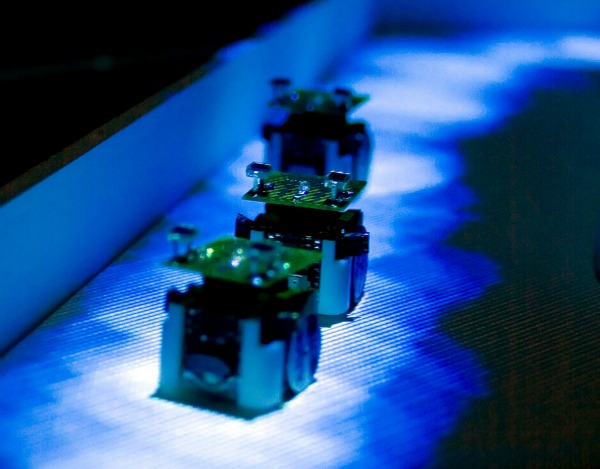Sugar Cube-Sized Robotic Ants Mimic Real Foraging Behavior
Researchers use tiny robots to study how ants navigate a labyrinth of networks, from the nest to the food and back again
![]()

Researchers used miniature robots to mimic how real ants maneuver networks of their own. Credit: Simon Garnier, et al
For ants, the pheromone-laden foraging trails they leave behind are like lifelines: they direct the workers toward food hubs discovered earlier and help guide them home back to their nest.
These networks of trails can stretch for hundreds of feet, quite the achievement considering many worker ants are less than half an inch in length. One type of harvester ant can lay down a set of trails (PDF) that stretch 82 feet from the entrance of its nest. The trails of a wood ant, an insect measuring just five millimeters (that’s one-fifth of an inch), reach 656 feet, each one branching out into more pathways at up to 10 spots on each trail. The leafcutter ant can build a network that spreads for almost two and a half acres.
Ant species such as these tend to take the shortest path between their colony’s nest and a food source, following branches that stray as little as possible from the direction in which they began their journey. The forks in their network of trails, known as bifurcations, are not symmetrical and don’t branch out into angles of the same size. But do ants use a sophisticated sense of geometry to trace their path, measuring the angles of the roads before picking one?
To learn more, researchers at the New Jersey Institute of Technology (NJIT) and the Research Centre on Animal Cognition in France used miniature robots to replicate the behavior of a colony of Argentine ants on the move, reported today in the journal PLOS Computational Biology. This ant species has extremely poor eyesight and darts around at high speeds, yet it can maneuver through corridor after corridor, from home to food and vice versa.
When no obstacles are around, ants prefer to walk in a straight line without deviating from their course. People are like that too: if we were walking down a street to a restaurant that’s on the same side of the road as we are, we wouldn’t cross to the opposite sidewalk unless something was blocking our way. To imbue this sense of obstacle avoidance into the robots, researchers programmed them to avoid obstacles and follow light trails, which the researchers used as a substitute for pheromone-coated paths.

An “Alice,” a tiny robot measuring two centimeters (just less than one inch), following a trail of light using two photoreceptors. Credit: Simon Garnier, et al
The 10 tiny robots in this study, called Alices, were then tasked to navigate a maze-like environment roughly 60 to 70 times their size, from a starting point representing a nest entrance to an end point signifying a food source. Two photoreceptors, mimicking ant antennae, detected beams of light. As the robots traveled through the maze, researchers introduced a wrench in the little machines’ plans—at random points in their journey, the robots were triggered to turn, a mechanism meant to further mimic ants’ meandering gaits as they creep along their paths. These random turns rotated at angles no greater than 30 degrees, as real ants are not very efficient at physically making U-turns.
In the sped-up video below, the researchers tested the Alices’ navigation skills in a complex network, charging them with choosing the shortest route between their “nest” (on the right) to a “food source (left). Varying beams of light projected onto the maze changed the robots’ movements inside the network as their photoreceptors kicked into action.
The researchers found that, without any knowledge of the geometry of the maze, the robotic ants behaved exactly as real ants do: they made small random turns, but moved in the same general direction. When they reached a fork in the road, this led the robots to choose the path that deviated least from their initial trajectory, even though they weren’t equipped to measure any angles. When they detected a light trail, they turned to follow that path.
The researchers say this means that Argentine ants may not need to use complex cognitive processes to compute the geometry of various trails. But taking the fork in the road that leads to the shortest route to food greatly increases foraging success for an entire colony. So using pheromones with an intuitive spatial knowledge of where food may be, keeps ants on the right track; as more ants follow the path to food, pheromones become more concentrated along the path, further helping to guide ants who have yet to travel. In fact, the navigation method of choosing the correct fork in the road triples the amount of food ants bring back to their nest than if they relied on pheromones alone, says lead author Simon Garnier, a biology professor at NJIT.
“If you have only the pheromones and you don’t have this trick, you’re less efficient because you’re more likely to get the ants trapped into loops,” says Garnier, who runs the institute’s Swarm Lab, which studies insect group behavior. “So they will reinforce their path around the loop, and they’ll just get stuck in this loop and turn and turn forever.”
Such navigation may also help guide ants through underground paths that connect different parts of their nests. Replicating these natural navigation tools allows researchers to better understand the inner-workings of collective animal behavior.
/https://tf-cmsv2-smithsonianmag-media.s3.amazonaws.com/accounts/headshot/marina-koren-240.jpg)
/https://tf-cmsv2-smithsonianmag-media.s3.amazonaws.com/accounts/headshot/marina-koren-240.jpg)